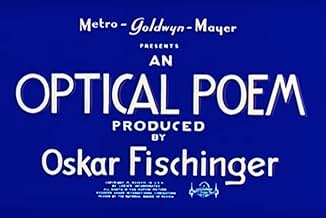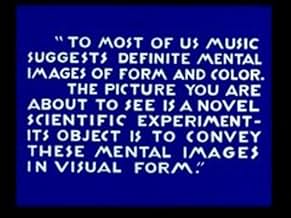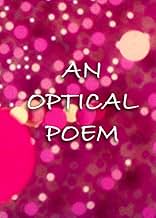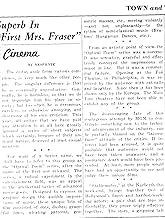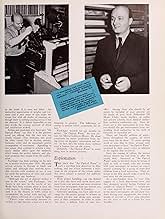Mental imagery of music is visualized with two-dimensional shapes dancing to the rhythm of Franz Liszt's Hungarian Rhapsody No. 2.Mental imagery of music is visualized with two-dimensional shapes dancing to the rhythm of Franz Liszt's Hungarian Rhapsody No. 2.Mental imagery of music is visualized with two-dimensional shapes dancing to the rhythm of Franz Liszt's Hungarian Rhapsody No. 2.
- Director
Featured reviews
I appreciated the soundtrack more than the abstract art, patterns of balloon-shaped dots that dance across the screen for six minutes while the 2nd Hungarian Rhapsody explodes with musical sounds.
After a few minutes, the short becomes too repetitious to be really novel. In fact, it's the sort of thing the Disney studio was already experimenting with and led to several short subjects, as well as the full-length feature "Fantasia" later on, combining classical music with unique animation.
But this was 1937 and the comparison to Disney was not made at the time. Nevertheless, I found it monotonous to watch and not unique enough, except for the exhilarating classical music performed.
After a few minutes, the short becomes too repetitious to be really novel. In fact, it's the sort of thing the Disney studio was already experimenting with and led to several short subjects, as well as the full-length feature "Fantasia" later on, combining classical music with unique animation.
But this was 1937 and the comparison to Disney was not made at the time. Nevertheless, I found it monotonous to watch and not unique enough, except for the exhilarating classical music performed.
Just about anyone who's ever made a music video especially an abstract one owes a debt of gratitude to Oskar Fischinger. This short film is a charming rendition of Liszt's Second Hungarian Rhapsody set to a dazzling series of colored dots, lines, flashes and vivid visual effects that often look like a Piet Mondrian painting come to life. Paul Marquardt's often cheeky orchestration far different from the one usually heard adds a quite inventive series of tonal effects to the film that only underscores the rambunctious appeal of Fischinger's animation. I remember seeing films like this from the 1960's and not realizing anyone had done anything this imaginative with the same format thirty years earlier and I can't for the life of me imagine what unsuspecting moviegoers who caught this in 1937 on a program headlined by an MGM feature of the period made of it!
It's an MGM animated short with Hungarian Rhapsody No. 2 by Franz Liszt playing. It's Technicolor. It's all bright colors and geometric shapes. It's a little experimental. It's interesting. Sometimes, the movement is pretty good, but other times, I want it to switch with the music tempo a lot more. One of the most compelling aspect of this piece of music is its many changes of tempo. The visuals need to match that better. This type of animated experiments have a long Hollywood history. Producer Oskar Fischinger would go on to do a sequence in Walt Disney's Fantasia (1940) which obviously drew inspiration from this.
Optical Poem, An (1937)
*** (out of 4)
This 6-minute animated short is considered by many to have been the inspiration for Disney's FANTASIA. This film contains various animated images being played to Franz Liszt's Hungarian Rhapsody No. 2 and makes for quite a ride. In his day, director Fischinger was pretty much overlooked and after during down a job offer from Disney, he would eventually be fired by both MGM and Paramount. His animation career never took off in the movies but years later his work began to be reevaluated and today's he's considered one of the best. This, considered his best film, is pretty strong in terms of its visual style even though it's rather simple. A blue background with various circles, squares and other images. The film moves along quite well, although the six-minutes do start to get a bit long towards the end.
*** (out of 4)
This 6-minute animated short is considered by many to have been the inspiration for Disney's FANTASIA. This film contains various animated images being played to Franz Liszt's Hungarian Rhapsody No. 2 and makes for quite a ride. In his day, director Fischinger was pretty much overlooked and after during down a job offer from Disney, he would eventually be fired by both MGM and Paramount. His animation career never took off in the movies but years later his work began to be reevaluated and today's he's considered one of the best. This, considered his best film, is pretty strong in terms of its visual style even though it's rather simple. A blue background with various circles, squares and other images. The film moves along quite well, although the six-minutes do start to get a bit long towards the end.
Abstract images float across the field in time to Liszt's Second Hungarian Rhapsody.
Oskar Fischinger had been producing this sort of abstract animation since 1924 in Germany as an outgrowth of the Dadaist movement. He was not the only film maker to at least dabble in this sort of work. Over in England, Len Lye started doing the same thing with the introduction of sound to films, and later, Norman McLaren would make several of his early shorts doing much the same. In fact, a couple of years after this came out, part of FANTASIA would do the same. It was a natural outgrowth of abstract art and program music, in which the music was meant to evoke emotions or scenes or even stories. They didn't call them etudes for no reason, but because they evoked enquiring thoughts. Only with abstract animation like this, the audience was called upon to go its own way, and perhaps afterwards discuss what it was all about.
Pretty colors, though. It reminds me of the days I was part of the light show crew at the Fillmore East.
Oskar Fischinger had been producing this sort of abstract animation since 1924 in Germany as an outgrowth of the Dadaist movement. He was not the only film maker to at least dabble in this sort of work. Over in England, Len Lye started doing the same thing with the introduction of sound to films, and later, Norman McLaren would make several of his early shorts doing much the same. In fact, a couple of years after this came out, part of FANTASIA would do the same. It was a natural outgrowth of abstract art and program music, in which the music was meant to evoke emotions or scenes or even stories. They didn't call them etudes for no reason, but because they evoked enquiring thoughts. Only with abstract animation like this, the audience was called upon to go its own way, and perhaps afterwards discuss what it was all about.
Pretty colors, though. It reminds me of the days I was part of the light show crew at the Fillmore East.
Did you know
- TriviaAs this was released two years before "Fantasia," it's reasonable to assume either Disney or someone who worked for him saw this and realized the possibilities of non-narrative animation set to classical music; certainly the "Toccata and Fugue in D Minor" sequence bears a striking similarity.
- Quotes
Prologue (Title): To most of us music suggests definite mental images of form and color. The picture you are about to see is a novel scientific experiment - Its object is to convey these mental images in visual form.
Details
- Release date
- Country of origin
- Language
- Also known as
- MGM Miniatures (1937-1938 Season) #5: An Optical Poem
- Production company
- See more company credits at IMDbPro
- Runtime
- 6m
- Aspect ratio
- 1.37 : 1
Contribute to this page
Suggest an edit or add missing content

